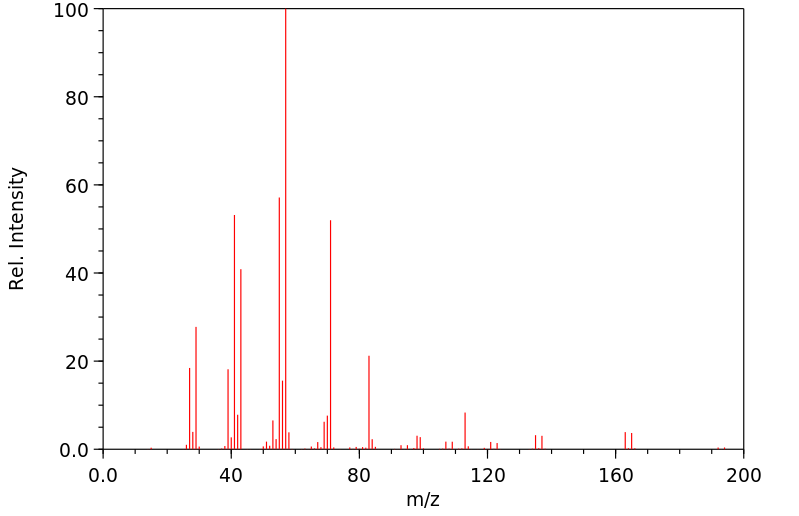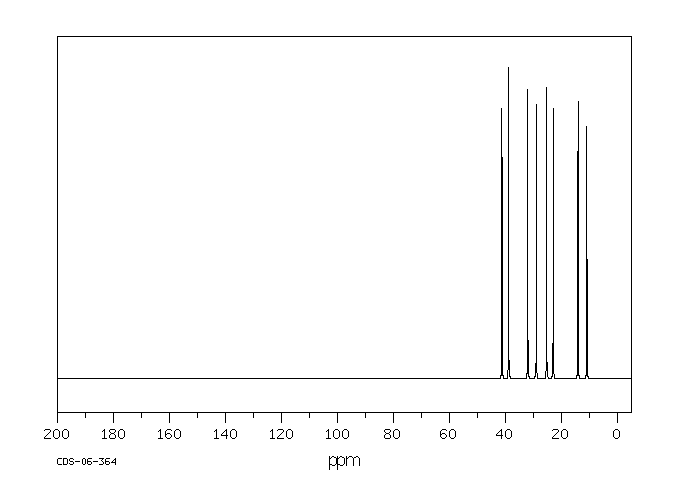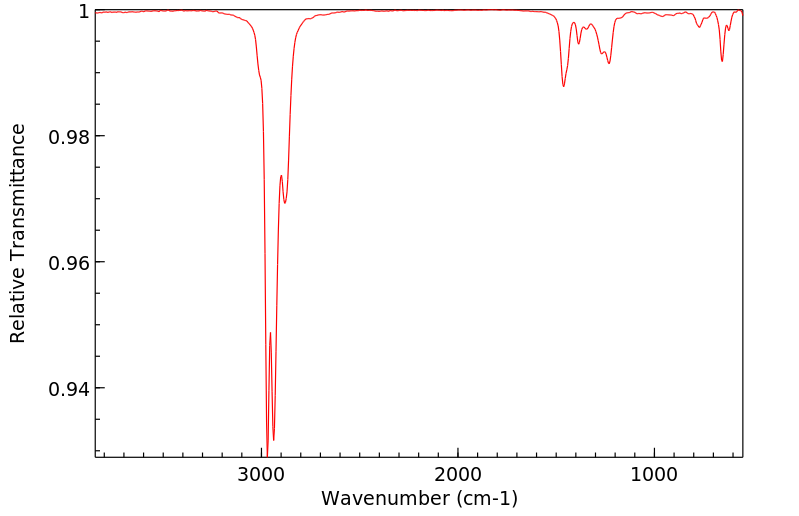溴代异辛烷 | 18908-66-2
中文名称
溴代异辛烷
中文别名
2-乙基己基溴;1-溴代异辛烷;异辛基溴;3-(溴甲基)庚烷;3-(溴乙基)庚烷;1-溴-2-乙基己烷;1-溴代-2-乙基己烷
英文名称
2-ethylhexyl bromide
英文别名
3-bromomethylheptane;1-bromo-2-ethylhexane;bromoisooctane;3-(bromomethyl)heptane
CAS
18908-66-2
化学式
C8H17Br
mdl
MFCD00000220
分子量
193.127
InChiKey
NZWIYPLSXWYKLH-UHFFFAOYSA-N
BEILSTEIN
——
EINECS
——
-
物化性质
-
计算性质
-
ADMET
-
安全信息
-
SDS
-
制备方法与用途
-
上下游信息
-
文献信息
-
表征谱图
-
同类化合物
-
相关功能分类
-
相关结构分类
物化性质
-
熔点:-55°C (estimate)
-
沸点:75-77 °C16 mm Hg(lit.)
-
密度:1.086 g/mL at 25 °C(lit.)
-
闪点:157 °F
-
溶解度:可溶于氯仿、乙酸乙酯
-
介电常数:5.0(Ambient)
-
保留指数:1083.2
-
稳定性/保质期:
在常温常压下稳定,应避免与氧化物接触。
计算性质
-
辛醇/水分配系数(LogP):4.5
-
重原子数:9
-
可旋转键数:5
-
环数:0.0
-
sp3杂化的碳原子比例:1.0
-
拓扑面积:0
-
氢给体数:0
-
氢受体数:0
安全信息
-
TSCA:Yes
-
危险品标志:Xi
-
安全说明:S26,S36/37/39,S37/39
-
危险类别码:R36/37/38
-
WGK Germany:3
-
海关编码:29033036
-
危险性防范说明:P501,P210,P264,P280,P302+P352,P370+P378,P337+P313,P305+P351+P338,P362+P364,P332+P313,P403+P235
-
危险性描述:H315,H319,H227
-
储存条件:本品应密封存放在阴凉避光的地方。
SDS
模块 1. 化学品
1.1 产品标识符
: 2-乙基己基溴
产品名称
1.2 鉴别的其他方法
1-Bromo-2-ethylhexane
1.3 有关的确定了的物质或混合物的用途和建议不适合的用途
仅用于研发。不作为药品、家庭或其它用途。
模块 2. 危险性概述
2.1 GHS-分类
易燃液体 (类别 4)
皮肤刺激 (类别 2)
眼睛刺激 (类别 2A)
特异性靶器官系统毒性(一次接触) (类别 3)
2.2 GHS 标记要素,包括预防性的陈述
象形图
警示词 警告
危险申明
H227 可燃液体
H315 造成皮肤刺激。
H319 造成严重眼刺激。
H335 可能引起呼吸道刺激。
警告申明
预防
P210 远离热源、火花、明火和热表面。- 禁止吸烟。
P261 避免吸入粉尘/烟/气体/烟雾/蒸气/喷雾.
P264 操作后彻底清洁皮肤。
P271 只能在室外或通风良好之处使用。
P280 戴防护手套/穿防护服/戴护目镜/戴面罩.
响应
P302 + P352 如皮肤接触:用大量肥皂和水清洗。
P304 + P340 如吸入: 将患者移到新鲜空气处休息,并保持呼吸舒畅的姿势。
P305 + P351 + P338 如与眼睛接触,用水缓慢温和地冲洗几分钟。如戴隐形眼镜并可方便地取
出,取出隐形眼镜,然后继续冲洗.
P312 如感觉不适,呼救中毒控制中心或医生.
P321 具体治疗(见本标签上提供的急救指导)。
P332 + P313 如发生皮肤刺激:求医/ 就诊。
P337 + P313 如仍觉眼睛刺激:求医/就诊。
P362 脱掉沾染的衣服,清洗后方可重新使用。
P370 + P378 火灾时: 用干的砂子,干的化学品或耐醇性的泡沫来灭火。
储存
P403 + P233 存放于通风良的地方。 保持容器密闭。
P403 + P235 存放在通风良好的地方。保持低温。
P405 存放处须加锁。
处置
P501 将内容物/ 容器处理到得到批准的废物处理厂。
2.3 其它危害物 - 无
模块 3. 成分/组成信息
3.1 物 质
: 1-Bromo-2-ethylhexane
别名
: C8H17Br
分子式
: 193.12 g/mol
分子量
组分 浓度或浓度范围
3-(Bromomethyl)heptane
-
化学文摘登记号(CAS 18908-66-2
No.) 242-659-9
EC-编号
模块 4. 急救措施
4.1 必要的急救措施描述
一般的建议
请教医生。 向到现场的医生出示此安全技术说明书。
吸入
如果吸入,请将患者移到新鲜空气处。 如呼吸停止,进行人工呼吸。 请教医生。
皮肤接触
用肥皂和大量的水冲洗。 请教医生。
眼睛接触
用大量水彻底冲洗至少15分钟并请教医生。
食入
禁止催吐。 切勿给失去知觉者通过口喂任何东西。 用水漱口。 请教医生。
4.2 主要症状和影响,急性和迟发效应
据我们所知,此化学,物理和毒性性质尚未经完整的研究。
4.3 及时的医疗处理和所需的特殊处理的说明和指示
无数据资料
模块 5. 消防措施
5.1 灭火介质
灭火方法及灭火剂
小(起始)火时,使用媒介物如“乙醇”泡沫、干化学品或二氧化碳。大火时,尽可能使用水灭火。使用大量(
洪水般的)水以喷雾状应用;水柱可能是无效的。用大量水降温所有受影响的容器。
5.2 源于此物质或混合物的特别的危害
碳氧化物, 溴化氢气
5.3 给消防员的建议
如必要的话,戴自给式呼吸器去救火。
5.4 进一步信息
用水喷雾冷却未打开的容器。
模块 6. 泄露应急处理
6.1 作业人员防护措施、防护装备和应急处置程序
使用个人防护用品。 避免吸入蒸气、烟雾或气体。 保证充分的通风。 移去所有火源。
人员疏散到安全区域。 谨防蒸气积累达到可爆炸的浓度。蒸气能在低洼处积聚。
6.2 环境保护措施
如能确保安全,可采取措施防止进一步的泄漏或溢出。 不要让产品进入下水道。
6.3 泄漏化学品的收容、清除方法及所使用的处置材料
围堵溢出,用防电真空清洁器或湿刷子将溢出物收集起来,并放置到容器中去,根据当地规定处理(见第13部
分)。 放入合适的封闭的容器中待处理。
6.4 参考其他部分
丢弃处理请参阅第13节。
模块 7. 操作处置与储存
7.1 安全操作的注意事项
避免接触皮肤和眼睛。 避免吸入蒸气和烟雾。
切勿靠近火源。-严禁烟火。采取措施防止静电积聚。
7.2 安全储存的条件,包括任何不兼容性
贮存在阴凉处。 使容器保持密闭,储存在干燥通风处。
打开了的容器必须仔细重新封口并保持竖放位置以防止泄漏。
建议的贮存温度: 2 - 8 °C
7.3 特定用途
无数据资料
模块 8. 接触控制和个体防护
8.1 容许浓度
最高容许浓度
没有已知的国家规定的暴露极限。
8.2 暴露控制
适当的技术控制
根据良好的工业卫生和安全规范进行操作。 休息前和工作结束时洗手。
个体防护设备
眼/面保护
带有防护边罩的安全眼镜符合 EN166要求请使用经官方标准如NIOSH (美国) 或 EN 166(欧盟)
检测与批准的设备防护眼部。
皮肤保护
戴手套取 手套在使用前必须受检查。
请使用合适的方法脱除手套(不要接触手套外部表面),避免任何皮肤部位接触此产品.
使用后请将被污染过的手套根据相关法律法规和有效的实验室规章程序谨慎处理. 请清洗并吹干双手
所选择的保护手套必须符合EU的89/686/EEC规定和从它衍生出来的EN 376标准。
身体保护
防渗透的衣服, 防护设备的类型必须根据特定工作场所中的危险物的浓度和数量来选择。
呼吸系统防护
如危险性评测显示需要使用空气净化的防毒面具,请使用全面罩式多功能防毒面具(US)或ABEK型
(EN
14387)防毒面具筒作为工程控制的候补。如果防毒面具是保护的唯一方式,则使用全面罩式送风防
毒面具。 呼吸器使用经过测试并通过政府标准如NIOSH(US)或CEN(EU)的呼吸器和零件。
模块 9. 理化特性
9.1 基本的理化特性的信息
a) 外观与性状
形状: 液体
颜色: 无色
b) 气味
无数据资料
c) 气味阈值
无数据资料
d) pH值
无数据资料
e) 熔点/凝固点
无数据资料
f) 沸点、初沸点和沸程
75 - 77 °C 在 21 hPa - lit.
g) 闪点
69 °C - 闭杯
h) 蒸发速率
无数据资料
i) 易燃性(固体,气体)
无数据资料
j) 高的/低的燃烧性或爆炸性限度 无数据资料
k) 蒸气压
无数据资料
l) 蒸汽密度
无数据资料
m) 密度/相对密度
1.086 g/cm3 在 25 °C
n) 水溶性
无数据资料
o) n-辛醇/水分配系数
无数据资料
p) 自燃温度
无数据资料
q) 分解温度
无数据资料
r) 粘度
无数据资料
模块 10. 稳定性和反应活性
10.1 反应性
无数据资料
10.2 稳定性
无数据资料
含有下列稳定剂:
Potassium carbonate (1 %)
10.3 危险反应
无数据资料
10.4 应避免的条件
热,火焰和火花。
10.5 不相容的物质
强氧化剂, 强碱
10.6 危险的分解产物
其它分解产物 - 无数据资料
模块 11. 毒理学资料
11.1 毒理学影响的信息
急性毒性
无数据资料
皮肤刺激或腐蚀
无数据资料
眼睛刺激或腐蚀
无数据资料
呼吸道或皮肤过敏
无数据资料
生殖细胞突变性
无数据资料
致癌性
IARC:
此产品中没有大于或等于 0。1%含量的组分被 IARC鉴别为可能的或肯定的人类致癌物。
生殖毒性
无数据资料
特异性靶器官系统毒性(一次接触)
吸入 - 可能引起呼吸道刺激。
特异性靶器官系统毒性(反复接触)
无数据资料
吸入危险
无数据资料
潜在的健康影响
吸入 吸入可能有害。 引起呼吸道刺激。
摄入 如服入是有害的。
皮肤 通过皮肤吸收可能有害。 造成皮肤刺激。
眼睛 造成严重眼刺激。
接触后的征兆和症状
据我们所知,此化学,物理和毒性性质尚未经完整的研究。
附加说明
化学物质毒性作用登记: 无数据资料
模块 12. 生态学资料
12.1 生态毒性
无数据资料
12.2 持久性和降解性
无数据资料
12.3 潜在的生物累积性
无数据资料
12.4 土壤中的迁移性
无数据资料
12.5 PBT 和 vPvB的结果评价
无数据资料
12.6 其它不良影响
无数据资料
模块 13. 废弃处置
13.1 废物处理方法
产品
此易爆炸产品可以在备有燃烧后处理和洗刷作用的化学焚化炉中燃烧
将剩余的和不可回收的溶液交给有许可证的公司处理。
联系专业的拥有废弃物处理执照的机构来处理此物质。
受污染的容器和包装
按未用产品处置。
模块 14. 运输信息
14.1 联合国危险货物编号
欧洲陆运危规: - 国际海运危规: - 国际空运危规: -
14.2 联合国运输名称
欧洲陆运危规: 非危险货物
国际海运危规: 非危险货物
国际空运危规: 非危险货物
14.3 运输危险类别
欧洲陆运危规: - 国际海运危规: - 国际空运危规: -
14.4 包裹组
欧洲陆运危规: - 国际海运危规: - 国际空运危规: -
14.5 环境危险
欧洲陆运危规: 否 国际海运危规 国际空运危规: 否
海洋污染物(是/否): 否
14.6 对使用者的特别提醒
无数据资料
模块 15 - 法规信息
N/A
模块16 - 其他信息
N/A
制备方法与用途
上下游信息
反应信息
-
作为反应物:参考文献:名称:Schulte et al., Hoppe-Seyler's Zeitschrift fur Physiologische Chemie, 1951, vol. 288, p. 69,71摘要:DOI:
-
作为产物:描述:参考文献:名称:三溴异氰尿酸/三苯膦:一种将醇转化为烷基溴化物的新系统摘要:在室温下,使用三溴异氰尿酸和三苯基膦(摩尔比1.0:0.7:2.0,醇/三溴异氰尿酸/三苯基膦)在二氯甲烷中,在中性条件下将醇转化为烷基溴的方法已经得到了开发,该方法简便易行。该方法可用于伯,仲,苄基和烯丙基醇的转化,并且其相应的溴化物以67-82%的产率获得。在这些条件下,叔醇不会发生反应。DOI:10.5935/0103-5053.20140055
-
作为试剂:参考文献:名称:Chauzov, V. A.; Studnev, Yu. N.; Rudnitskaya, L. S., Journal of general chemistry of the USSR, 1989, vol. 59, # 5.1, p. 928 - 931摘要:DOI:
文献信息
-
Some Aspects of the Azide-Alkyne 1,3-Dipolar Cycloaddition Reaction作者:N. T. Pokhodylo、M. A. Tupychak、O. Ya. Shyyka、M. D. ObushakDOI:10.1134/s1070428019090082日期:2019.9Some peculiar features of two most commonly used catalytic systems (Cul and CuSOVsodium ascorbate) controlling the regioselectivity of 1,3-dipolar cycloaddition of azides to terminal alkynes have been studied. Their potentialities, main disadvantages, and limitations have been demonstrated by a number of examples, including reactions of low-molecular-weight azides and alkynes containing heterocyclic
-
Topical Mosquito Repellents VII: Alkyl Triethylene Glycol Monoethers作者:H. Johnson、J. Degraw、J. Engstrom、W.A. Skinnerx、V.H. Brown、D. Skidmore、H.I. MaibachDOI:10.1002/jps.2600640428日期:1975.4Normal and branched-chain aliphatic monoethers of triethylene glycol are effective topical mosquito repellents. In terms of duration of protection, they are generally superior to the corresponding diethylene glycol analogs and some are superior to diethyltoluamide. The n-heptyl monoether of triethylene glycol affords double the protection time of diethyltoluamide under controlled laboratory conditions
-
One-Component Multifunctional Sequence-Defined Ionizable Amphiphilic Janus Dendrimer Delivery Systems for mRNA作者:Dapeng Zhang、Elena N. Atochina-Vasserman、Devendra S. Maurya、Ning Huang、Qi Xiao、Nathan Ona、Matthew Liu、Hamna Shahnawaz、Houping Ni、Kyunghee Kim、Margaret M. Billingsley、Darrin J. Pochan、Michael J. Mitchell、Drew Weissman、Virgil PercecDOI:10.1021/jacs.1c05813日期:2021.8.11efficiency. Here, we report the development of a one-component multifunctional ionizable amphiphilic Janus dendrimer (IAJD) delivery system for mRNA that exhibits high activity at a low concentration of ionizable amines organized in a sequence-defined arrangement. Six libraries containing 54 sequence-defined IAJDs were synthesized by an accelerated modular-orthogonal methodology and coassembled with核酸的有效病毒或非病毒递送是基因纳米医学的关键步骤。病毒和合成载体都已成功用于基因传递,最近的例子是基于 DNA、腺病毒和 mRNA 的 Covid-19 疫苗。病毒载体可以针对特定目标且非常有效,但也可以介导严重的免疫反应、细胞毒性和突变。四组分脂质纳米颗粒 (LNP) 包含可电离脂质、磷脂、用于机械性能的胆固醇和用于稳定性的 PEG 缀合脂质,代表了当前领先的 mRNA 非病毒载体。然而,中性可电离脂质在 LNP 核心中分离为液滴、“PEG 困境”以及仅在极低温度下的稳定性限制了它们的效率。这里,我们报告了一种用于 mRNA 的单组分多功能可电离两亲性两亲树枝状聚合物 (IAJD) 递送系统的开发,该系统在以序列定义的排列组织的低浓度可电离胺下表现出高活性。包含 54 个序列定义的 IAJD 的六个文库通过加速模块化正交方法合成,并通过简单的注射方法而不是通常用于 LNP 的复杂微流体技术与
-
A Mild and General One-Pot Synthesis of Densely Functionalized Diaryliodonium Salts作者:Linlin Qin、Bao Hu、Kiel D. Neumann、Ethan J. Linstad、Katelyenn McCauley、Jordan Veness、Jayson J. Kempinger、Stephen G. DiMagnoDOI:10.1002/ejoc.201500986日期:2015.9Diaryliodonium salts are powerful and widely used arylating agents in organic chemistry. Here we report a scalable, synthesis of densely functionalized diaryliodonium salts from aryl iodides under mild conditions. This two-step, one-pot process has remarkable functional group tolerance, is compatible with commonly employed acid-labile protective group strategies, avoids heavy metal and transition metal
-
[EN] OXIME ESTER PHOTOINITIATORS<br/>[FR] PHOTO-INITIATEURS À BASE D'ESTER D'OXIME申请人:BASF SE公开号:WO2021175855A1公开(公告)日:2021-09-10Disclosed are α-oxo oxime ester compounds based on carbazole derivatives which have specific substituent groups useful as a photoinitiator, as well as photopolymerizable compositions comprising said photoinitiator and ethylenically unsaturated compounds. The photopolymerizable compositions are useful, for example, in photoresist formulations for display applications, e.g. liquid crystal display (LCD), organic light emitting diode (OLED) and touch panel.
表征谱图
-
氢谱1HNMR
-
质谱MS
-
碳谱13CNMR
-
红外IR
-
拉曼Raman
-
峰位数据
-
峰位匹配
-
表征信息
同类化合物
(3-溴-1-丙炔-1-基)环丙烷
马杜拉霉素
顺-3,顺-6-1-溴壬二烯
顺,反,顺-1,2,3,4-四(2-溴乙基)环丁烷
金刚烷-2,2-d2
辛烷,1,5-二溴-
苯并噻唑,6-异硫氰酸根合5-甲基-(9CI)
苯(甲)醛,3-甲氧基-4-硝基-
硬脂基溴
硫杂二溴化
癸基溴
甲基环丙基溴化镁
环戊醇1-乙基-3-(苯甲基)-(9CI)
环戊烯-1,3-溴-(7CI,9CI)
环丙烷,1-溴-1-(3,3-二甲基-1-丁炔基)-2,2-二甲基-
环丁基溴
溴甲基环戊烷
溴甲基环己烷
溴甲基环丙烷
溴甲基环丁烷
溴甲基
溴环戊烷-D9
溴己烷-D3
溴己烷
溴化环辛基甲基
溴代环辛烷
溴代环戊烷
溴代环庚烷
溴代环丙烷
溴代异辛烷
溴代异丁烷
溴代叔丁烷-D9
溴代叔丁烷
溴代十四烷-D29
溴代十四烷
溴代十六烷-D33
溴代十六烷
溴代十五烷
溴代十二烷
溴代二十烷
溴乙醛
溴乙烷-D3
溴乙烷-D1
溴乙烷-2-13C
溴乙烷-13C2
溴乙烷-1-13C
溴乙烷-1,1-d2
溴乙烷-1,1,2,2-d4
溴乙烷
溴丙烷-D4










